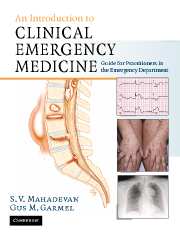Book contents
- Frontmatter
- Contents
- List of contributors
- Foreword
- Acknowledgments
- Dedication
- Section 1 Principles of Emergency Medicine
- 1 Approach to the emergency patient
- 2 Airway management
- 3 Cardiopulmonary and cerebral resuscitation
- 4 Cardiac dysrhythmias
- 5 Shock
- 6 Traumatic injuries
- 7 Prehospital care and emergency medical services
- 8 Pain management
- Section 2 Primary Complaints
- Section 3 Unique Issues in Emergency Medicine
- Section 4 Appendices
- Index
2 - Airway management
Published online by Cambridge University Press: 27 October 2009
- Frontmatter
- Contents
- List of contributors
- Foreword
- Acknowledgments
- Dedication
- Section 1 Principles of Emergency Medicine
- 1 Approach to the emergency patient
- 2 Airway management
- 3 Cardiopulmonary and cerebral resuscitation
- 4 Cardiac dysrhythmias
- 5 Shock
- 6 Traumatic injuries
- 7 Prehospital care and emergency medical services
- 8 Pain management
- Section 2 Primary Complaints
- Section 3 Unique Issues in Emergency Medicine
- Section 4 Appendices
- Index
Summary
Scope of the problem
Airway management is arguably the single most important skill taught to and possessed by emergency physicians. It represents the “A” of the mnemonic ABC (Airway, Breathing, Circulation), which forms the foundation for the resuscitation of critically ill and injured patients. Airway management encompasses the assessment, establishment and protection of the airway in combination with effective oxygenation and ventilation. Timely effective airway management can mean the difference between life and death, and takes precedence over all other clinical considerations with the sole exception of immediate defibrillation of the patient in cardiac arrest due to ventricular fibrillation.
This chapter reviews airway anatomy and assessment, approaches for noninvasive airway management, and indications and techniques for definitive airway management. The approach to the challenging patient with a difficult or failed airway will also be explored, as well as specialized devices, techniques and medications employed in these challenging clinical situations.
Anatomic essentials
A clear understanding of airway anatomy is requisite for advanced airway management. Internally, the airway is made up of many structures and well-defined spaces. It originates at the nasal and oral cavities (Figure 2.1). The nasal cavity extends from the nostrils to the posterior nares or choana. The nasopharynx extends from the end of the nasal cavity to the level of the soft palate. The oral cavity is bounded by the teeth anteriorly, hard and soft palate superiorly and the tongue inferiorly.
- Type
- Chapter
- Information
- An Introduction to Clinical Emergency MedicineGuide for Practitioners in the Emergency Department, pp. 19 - 46Publisher: Cambridge University PressPrint publication year: 2005

